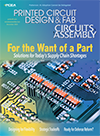News
BRUSSELS – In the wake of a recent successful discovery of a counterfeit component ring, EU and U.S. officials said today they would crack down on further counterfeiting.
China will be a focus of the operation, officials said.
The announcement stems from recent operations at major airports during which some 360,000 counterfeit parts, representing more than 40 brands, were uncovered. The seized parts were valued at more than $1.3 billion.
"Traffickers and counterfeiters have become much more sophisticated.… They are no longer confining themselves to trafficking in some of the traditional goods we used to see them in, such as footwear or handbags," U.S. Customs and Border Protection assistant commissioner Dan Baldwin said, according to published reports.
"There are increasing numbers with high-tech goods, goods that impact our critical infrastructure," he added.
The U.S. and EU said they would cooperate with importers to discover how fakes enter the market, and would initiate investigations, focusing on China, a large hub for counterfeit components.
Some of the fakes found, however, came from Taiwan and Hong Kong, most arriving by plane through couriers, according to John Pulford, a European Commission official.
The customs operation took place in German airports, France's Roissy-Charles-de-Gaulle airport, London’s Heathrow, and many hubs in the U.S.
China will be a focus of the operation, officials said.
The announcement stems from recent operations at major airports during which some 360,000 counterfeit parts, representing more than 40 brands, were uncovered. The seized parts were valued at more than $1.3 billion.
"Traffickers and counterfeiters have become much more sophisticated.… They are no longer confining themselves to trafficking in some of the traditional goods we used to see them in, such as footwear or handbags," U.S. Customs and Border Protection assistant commissioner Dan Baldwin said, according to published reports.
"There are increasing numbers with high-tech goods, goods that impact our critical infrastructure," he added.
The U.S. and EU said they would cooperate with importers to discover how fakes enter the market, and would initiate investigations, focusing on China, a large hub for counterfeit components.
Some of the fakes found, however, came from Taiwan and Hong Kong, most arriving by plane through couriers, according to John Pulford, a European Commission official.
The customs operation took place in German airports, France's Roissy-Charles-de-Gaulle airport, London’s Heathrow, and many hubs in the U.S.
WASHINGTON – The United States Patent and Trademark Office has assigned a patent to Sono-Tek Corp. covering the creation of thin organic films on complicated substrates using ultrasonic nozzles in combination with a vacuum system.
The patent covers a process for coating 3-D substrates with thin organic films and products. Applications include coating of implantable medical devices such as drug-coated cardiac stents, diabetes monitors, and other geometries.
Sono-Tek, a developer of ultrasonic spray technology, markets the invention under the name MediSonic.
The patent covers a process for coating 3-D substrates with thin organic films and products. Applications include coating of implantable medical devices such as drug-coated cardiac stents, diabetes monitors, and other geometries.
Sono-Tek, a developer of ultrasonic spray technology, markets the invention under the name MediSonic.
SAN JOSE – The MicroElectronics Packaging and Test Engineering Council has finalized the program for its 4th Annual Thermal Management symposium.
The one-day event will be held Feb. 28 in San Jose.
Verdant Electronics president Joe Fjelstad will keynote the symposium, reviewing innovative ways engineers have responded to thermal challenges over time. His presentation, Beating the Heat – Dealing with the Thermal Challenge: Past, Present and Future, will look at some new and prospective materials and methods being developed to address thermal challenges.
Sessions include Thermal Solutions for Tomorrow’s ICs; Using Fine Grain, Full Chip Thermal Analysis to Solve SOC Design Issues; Thin-Film Thermoelectric Cooling for 3D Packages; Returning to Processor Roots Resolves Thermal Issues; WW Package Characterization, STATS ChipPac; Metal Thermal Interface Materials for the Electronics Industry; High Performance Modules on Copper Substrates; Thermal Interface Materials for IC Cooling - Design Considerations and Trends; Telecommunications - Power Users are Power Hungry; Applied Thermal Technologies - Telecom Equipments: Hard Limiting Factors and Opportunities; Leveraging FPGA Features to Address Power Management Challenges; Thermal Measurement and Characterization of a Multi-die Opto-Coupler; Green Technology – Fighting Global and Local Warming; Thermal Management for Advanced Electric Powertrain; Thermal Management in Fuel Cells, and Thermal Management Considerations in the Design of Solar Concentrators.
To register, visit www.meptec.org.


